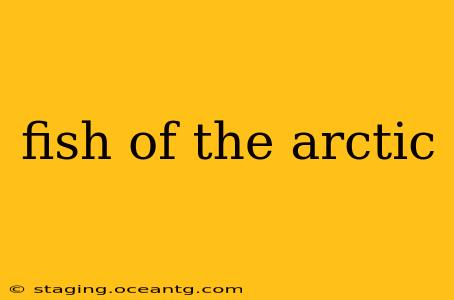The Arctic, a land of ice and snow, harbors a surprisingly diverse and resilient ecosystem, particularly within its frigid waters. While the harsh conditions challenge even the hardiest creatures, a remarkable array of fish species have adapted to thrive in these extreme environments. This article will explore the fascinating world of Arctic fish, delving into their adaptations, unique characteristics, and the challenges they face in a changing climate.
What are some common fish found in the Arctic Ocean?
The Arctic Ocean isn't a monolithic environment; different regions support diverse fish communities. Some of the most common species include:
-
Arctic Cod (Boreogadus saida): This small, schooling fish is a keystone species, forming the base of the Arctic food web. It's incredibly abundant and serves as a crucial food source for many larger predators. Its adaptation to the cold includes antifreeze proteins in its blood.
-
Polar Cod (Arctogadus glacialis): Another vital species, the polar cod shares a similar ecological role to the Arctic cod. It’s found in deeper waters and is characterized by its slow growth rate and long lifespan.
-
Capelin (Mallotus villosus): These small, silvery fish are known for their large spawning runs, attracting many predators. They are an important food source for seabirds, seals, and even whales.
-
Arctic Char (Salvelinus alpinus): A member of the salmon family, Arctic char are found in both freshwater and saltwater environments. They exhibit remarkable phenotypic plasticity, meaning their appearance and behavior can vary significantly based on their habitat.
What adaptations do Arctic fish have to survive in cold water?
Surviving in the Arctic Ocean requires specialized adaptations. These fish have evolved several key characteristics to thrive in these icy conditions:
-
Antifreeze Proteins: Many Arctic fish produce antifreeze proteins in their blood, preventing ice crystals from forming and damaging their cells. This is crucial for survival in sub-zero temperatures.
-
High Unsaturated Fat Content: Their bodies contain high levels of unsaturated fats, which maintain cell membrane fluidity even at very low temperatures. This ensures proper cellular function in the cold.
-
Slow Metabolism: A slower metabolism helps conserve energy in an environment where food can be scarce.
-
Behavioral Adaptations: Some species exhibit behavioral adaptations, such as seeking out deeper, warmer waters during the harshest periods of winter.
How do Arctic fish survive the long, dark winters?
The Arctic winter presents unique challenges. The extended periods of darkness and limited sunlight impact food availability and reproduction. Arctic fish have adapted in several ways:
-
Reduced Metabolic Rates: Lower metabolic rates help conserve energy during periods of food scarcity.
-
Delayed Reproduction: Some species delay their reproduction until conditions become more favorable, ensuring the survival of their offspring.
-
Efficient Feeding Strategies: They are highly efficient at finding and consuming available prey, often relying on highly sensitive sensory systems to locate food in dark and murky waters.
What are the threats to Arctic fish populations?
While remarkably resilient, Arctic fish populations face increasing threats:
-
Climate Change: Rising water temperatures, melting sea ice, and changes in ocean currents are significantly altering Arctic ecosystems, impacting the distribution and abundance of fish populations.
-
Ocean Acidification: Increased carbon dioxide absorption by the ocean is leading to acidification, harming the shells of some invertebrates that are a vital part of the Arctic food web, potentially affecting fish populations indirectly.
-
Pollution: Pollution from human activities, such as oil spills and industrial waste, can have devastating impacts on Arctic fish and their habitats.
-
Overfishing: While not as prevalent as in other regions, unsustainable fishing practices can still threaten some Arctic fish populations.
Are Arctic fish a significant food source for humans?
Arctic fish are an important food source for many Indigenous communities in the Arctic regions. Sustainable fishing practices are crucial for maintaining these resources for future generations.
The Arctic fish community is a testament to the incredible adaptability of life. Understanding these fascinating creatures and the challenges they face is crucial for effective conservation efforts and preserving this vital ecosystem for years to come.
